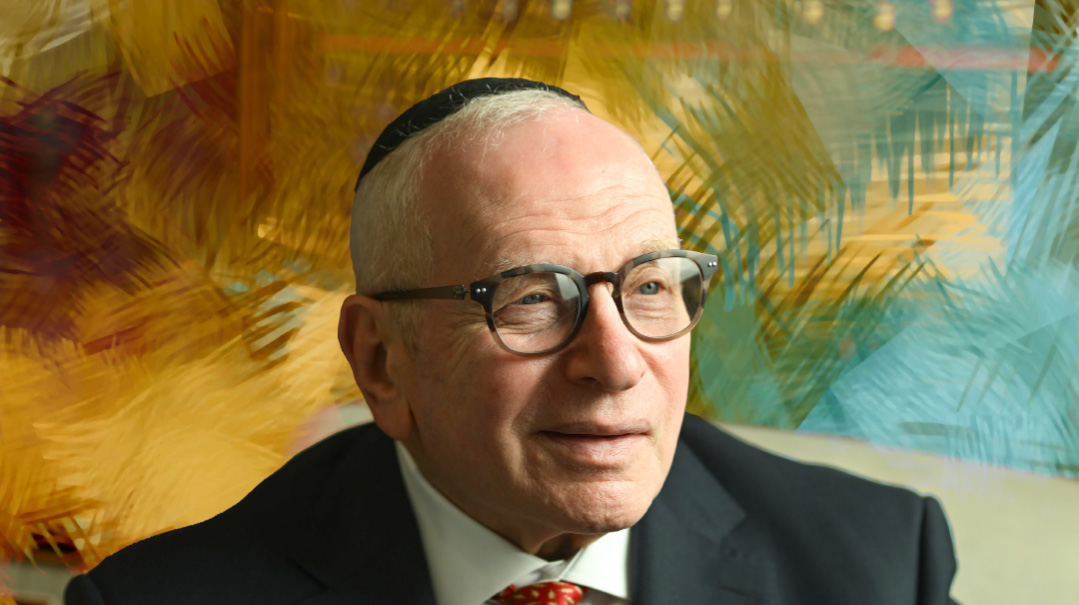Fighting the Good Fight

Dr. Shloimie Zimmerman transforms the taboo into a toolbox for growth and greatness

Photos: Naftoli Goldgrab
When Dr. Shloimie Zimmerman embarked on his groundbreaking project to help parents guide their sons to find the very real greatness that lies in the struggle for kedushah, he faced seemingly insurmountable obstacles. Only his belief in the necessity of what he was doing helped him to persevere. But even he could not have imagined how great a need his work would fill, as legions of parents rushed forward to grasp the ammunition they needed to arm their sons for history’s last stand
The soft ombre of turquoise and aquamarine on the front cover connoted a tranquil approachability, entrée to a world of serenity. But its title, From Boys to Men, stamped in bold sans-serif type, demanded candidness. A similar sense of forthrightness is exuded by four small words typed in Hebrew toward the cover’s top: Zeh hakatan gadol yiheyeh (this small one will become great).
It’s a contrast reflecting a series of tensions that run throughout the book’s content. This work presents a distinct and unafraid guide with full recognition of the gravity of its subject, while simultaneously insisting on sensitivity, sympathy, and understanding.
Dr. Shloimie Zimmerman, the book’s author, gained international acclaim within weeks of the book’s debut appearance, becoming the face of what can be justifiably termed a movement, a radical shift in the way we educate our children and students at the most crucial stages in their lives.
But his peerless success can only be explained by the final line on the book’s cover: “Foreword by HaRav Aharon Feldman.”
While Dr. Zimmerman could have drafted a brilliant work based solely on his experience and expertise as a mental health professional, he chose otherwise. Every stage of its development was discussed in-depth with gedolei Torah and it is their vision and perspective that the book seeks to execute.
It covers a wide range of subjects, all of which revolve around, or stem from, the vast challenges teenage boys endure with inyanei kedushah as their minds and bodies rapidly develop and hormone levels fluctuate wildly. It provides a wealth of insight into the psychology behind so many of these struggles along with numerous antidotes and preventative measures.
Dr. Zimmerman insists that the blazing nisyonos presented by today’s decadence are not random: Hashem chose us, this final generation, to haul history through its closing chapter.
And then a humble nation who fought mightily to stave off an enormous enemy will stand tall and proud.
Zeh hakatan gadol yiheyeh.
Facing the Pain
“I saw pain everywhere.” As Dr. Zimmerman recounts what drew him into the mental health field, even today, some 20 years later, the pain he witnessed continues to lace his voice.
Becoming a mental health professional wasn’t a childhood dream of his. In fact, it wasn’t until his early twenties, when he was in his fourth year of beis medrash, that the notion began to percolate in his mind. Sitting together in his Flatbush office, over a much-needed tall cup of black coffee, he shares how it all began.
Born and bred in Brooklyn, a young Shloimie Zimmerman attended Mesivta Tiferes Yisroel for high school, the Brooklyn branch of the Chofetz Chaim network of yeshivos. Following graduation he continued on the Chofetz Chaim track, joining its Queens-based beis medrash program.
“I was learning with extreme intensity,” he recounts. And he reiterates, “Like, very extreme.”
But this did not alarm him. It wasn’t until a specific incident that he began to take greater note of its import — and its impact.
Shloimie entered a new zeman ready to learn with a chavrusa who he knew to be excellent in learning. They assumed their places in the beis medrash, but, about an hour in, his chavrusa suddenly closed his Gemara and ran out of the beis medrash. Utterly perplexed, Shloimie asked his friends if they knew what had just happened.
“I learned that this boy suffered from frequent panic attacks, caused by his immense sense of pressure to learn as much as possible,” he recounts. “His instructions from his therapists for when he felt an attack coming on were to immediately leave the beis medrash.”
The experience somewhat shocked Shloimie and compelled him to begin looking more deeply into his own relationship with his learning. “I started asking myself — why is it that time seems to go so slowly when I learn?”
He began to have open conversations with his chavrusa, peeling away layer after layer of undetected impediments, in a mutual journey of self-discovery. Soon, these conversations took on more of a chaburah form as several others joined.
After that fourth year in beis medrash, Shloimie moved on to learn in Yeshivas Zichron Aryeh, where his nascent discernment for mental and emotional nuances intensified into an all-consuming passion.
Rav Shaya Cohen, the rosh yeshivah of Zichron Aryeh, also runs a program called Priority-1 for boys struggling with their Yiddishkeit. Shloimie became close with some of these boys and gained an up-close perspective of the emotional turmoil they lived with. It was this that Dr. Zimmerman was referring to when he said he “saw pain everywhere.”
He remembers one particular boy he befriended. “He was high all day. He would do anything to drown out his pain.” Until it was over. “One day he overdosed. He was gone.”
The experience struck Shloimie like a thunderbolt. He had to do something about this. He had to be there to ease the pain of others.
In 2004, he enrolled in Pace University’s psychology doctoral program. High-intensity schedule notwithstanding, Shloimie did find time to get married during this first year of schooling; he and his kallah Devorah (nee Goldfinger) celebrated one of their sheva brachos in the back of a classroom in Hofstra, where the new kallah was training in industrial organizational psychology.
Sometime around the year 2009, Shloimie’s final year in school, he was approached by his mother-in-law, Mrs. Sharon Goldfinger, and her close friend, Mrs. Aviva Hoch, both Shalom Task Force board members who jointly ran an after-school mentoring program called Bridges. Various occurrences in the community were indicating the need for increased vigilance about children’s safety, and they felt his involvement would be critical.
After brainstorming together, they concluded that the best option would be to make contact with Mrs. Debbie Fox of Los Angeles, founder of Magen Yeladim, a program that educates children and parents on these sensitive matters, giving them the tools needed to prevent such dreadful occurrences.
A meeting with the local Vaad Harabanim was arranged, where Shloimie expressed the urgency of the matter, and subsequently, Magen New York was founded.
In the meantime, Shloimie — now Dr. Zimmerman — graduated school and needed to fill his required 1,500 hours of supervised internship. This was in 2009, in the midst of the Great Recession, and finding employment, even as an intern, was exceedingly difficult. While graduates usually intern in mental health programs, Dr. Zimmerman studied the statute carefully and noted that, from a technical perspective, he could satisfy the requirements interning under a lone practitioner.
Dr. Zimmerman turned to Dr. Benzion Sorotzkin, one of just a handful of mental health professionals within the yeshivah community at the time.
“Dr. Sorotzkin taught me to believe in the power of the neshamah,” Dr. Zimmerman says. “When I first started, he told me, ‘Right now, you haven’t yet seen just how powerful the neshamah is and how it’s able to overcome even the most difficult challenges. But trust me, with time, you will see it firsthand.’ ”
Dr. Sorotzkin also introduced Dr. Zimmerman to the approach of blending Torah with psychology, demonstrating how Divine wisdom is the source of all wisdom. This model would ultimately serve as the inspiration for Dr. Zimmerman’s From Boys to Men.
Dr. Sorotzkin stood behind his new protégé, and soon enough, the clients started coming.
“Dr. Sorotzkin really believed in me,” says Dr. Zimmerman. “Shortly into my time there he began sending me the most complex cases.”
The experience lent the very fresh graduate deep insight into a broad range of mental health issues, including depression, anxiety, obsessive compulsive disorder, perfectionism, and trauma.
This, along with his involvement in abuse intervention, pivoted Dr. Zimmerman into a leading voice within the frum community on issues of abuse and molestation. Within a few short years of his graduation, he would be lecturing at and managing workshops for leading organizations such as Torah Umesorah, Agudath Israel, and many others.
Struggle for Sanctity
In 2018, Dr. Zimmerman was asked to join a group of instructors from Guard Your Eyes, an organization that provides free and anonymous help for those struggling with inyanei kedushah, to help compile a resource for educators on how to discuss these challenges with bar mitzvah-age children. This would be a follow-up resource to the pamphlet “Kedusha Talk” written by Rabbi Avi Landa, also published by Guard Your Eyes. “They had many mareh mekomos to work with and I spent a significant amount of time piecing these together to create the booklet.”
But the experience got Dr. Zimmerman thinking. Through his work with Magen New York, he had developed a strong belief that these matters should primarily be discussed between parent and child, rather than educator to student. Parents, he felt, could perform the task well. But they needed to be empowered. They needed a methodology that enabled them to communicate the concepts in a sensitive manner, and they also needed the confidence that they were acting in line with the Torah’s perspective on these issues.
He got to thinking. What about taking this beyond a privately distributed circular? What if this could be expounded upon, developed, and published as a formal book, available for all parents to read?
The book would be helpful for educators as well — their input would certainly be needed, especially once children got older and the struggle that more real. But parents, he states firmly, must at least be given a chance. This, he says, was the tradition throughout all the years — for parents to be the ones to explain the basic concepts with their children. On many levels, he asserts, it is a far healthier and safer model than leaving it to the educators.
Dr. Zimmerman got to work, compiling an immense amalgamation of theories accepted in conventional mental health circles; insights he gained based on his own experiences; and, most importantly, a vast amount of sources from Chazal, Rishonim, and Acharonim about this issue. Many of these originated from the Guard Your Eyes compilation, joined by many more from Dr. Zimmerman’s own research. (Dr. Zimmerman has a pamphlet containing just the book’s Torah sources and the relevant excerpts — it runs for 94 pages.)
But even after all that, he still faced an enormous hurdle. “I knew that for the book to be successful, it needed the blessings of gedolei Yisrael,” he said. After working on numerous sensitive communal matters, Dr. Zimmerman had developed a very close relationship with Rav Elya Brudny, rosh yeshivah of the Mirrer Yeshiva of Brooklyn, and so he approached him for a letter of approbation. Rav Brudny agreed, with one firm condition.
“Because this is so sensitive,” he said, “I want one other rav to sign off as well. Once there are two rabbanim it will make a much greater impact on the community.”
Rav Brudny also suggested that Dr. Zimmerman send the manuscript to Rav Yosef Elefant of the Mir in Yerushalayim for his review. Dr. Zimmerman did so and Rav Elefant ultimately returned the manuscript with many edits and suggestions, all of which he accepted.
But Rav Brudny’s written approval hinged on finding another rav willing to endorse the book, and at first, Dr. Zimmerman struggled to find one. “The book discusses extremely delicate issues and many gedolim were hesitant about signing off on it,” he explains. At some point someone suggested he simply publish it without rabbinic approbations, but he wouldn’t hear of it. The gedolim’s input, guidance, blessing, and approval were critical. “It hit a point where I really thought it wouldn’t happen,” he says. “I had spent hundreds of hours working on it but it seemed it would all go to waste.”
Preparing to shelve the project, he felt deeply despondent. “And then, one Friday night, I read a quote from Rabbi Jonathan Sacks, where he described how he had a lifelong dream to write a book and consistently failed. One day, as he was approaching his fortieth birthday, he came across George Bernard Shaw’s preface to where he writes that ‘If you are going to write a book, write it by the time you’re 40.’
“Rabbi Sacks was 40 years old when he read this. He said that, when seeing this line, he thought to himself, He’s talking to me and he’s not even alive! This inspired Rabbi Sacks to launch a renewed effort to publish a book, which he did. Ever since then, he succeeded in publishing a book nearly every single year.
“I read this and started to cry,” Dr. Zimmerman says. “I was 41 years old then — I truly felt like this was a message straight from Hashem telling me not to give up.”
After that, Dr. Zimmerman managed to get in touch with the rosh yeshivah of Ner Yisroel, Rav Aharon Feldman.
“He read through the book and had many comments and words of direction. I worked with these and made very significant changes.”
Once he had done so, Rav Feldman agreed to write a letter of approbation. “There should also be a foreword,” he said, “written by a rav.”
“Perhaps,” Dr. Zimmerman responded, “the Rosh Yeshivah would do it.”
Rav Feldman agreed.
It was a milestone to celebrate, but Dr. Zimmerman wanted more. He specifically wanted the blessings of Rav Shmuel Kamenetsky as well as those of his son, Rav Sholom. “When Rav Sholom explained the book’s content to Rav Shmuel,” Dr. Zimmerman shares, “Rav Shmuel said, ‘mir darfen epes tuhn, mir darfen epes tuhn [we must do something, we must do something].”
Rav Shmuel read the book and issued a short but heartfelt letter where he refers to Dr. Zimmerman as a “mumcheh b’kochos hanefesh — an expert in the powers of the spirit” who is “masur b’lev v’nefesh l’hachzik libos shvuros v’umlalos — devoted heart and soul to strengthen broken and despondent hearts.”
Dr. Zimmerman ultimately collected numerous other letters of approbation as well.
Stunning Impact
The book hit the stands in September of 2022 and has seen stunning success. It has sold some 21,000 copies to date, including 1,000 downloads of the audiobook version, making it Mosaica Press’s most successful publication ever. A shipment of the fifth reprint will be arriving on American shores sometime before or after Pesach.
“Wherever I go,” Dr. Zimmerman shares, “literally wherever I go, from Toronto to the Kosel, people approach me and tell me that had they read just a few lines of my book as young teenagers, their entire lives would have been different.”
“I was once at a simchah,” he says, “when someone walked over to me and said, ‘Your book would have changed my entire life if I had read it when I was a kid.’ ”
Then he reached into his pocket and produced a checkbook and a pen. He scribbled something on a check and handed it to Dr. Zimmerman.. “Here is $10,000,” he said. “Use it to spread your message.”
On a different occasion, Dr. Zimmerman received an anonymous check for $20,000, also for the purpose of furthering his mission.
Dr. Zimmerman shows me a Google Doc in which he compiled the various messages of feedback that he received. The dozens of notes come from all across the world, written by grown men, fathers, mothers, rebbeim, and menahalim.
“It is important to note,” Dr. Zimmerman says, “that the book is meant for parents and educators. Not for the teens themselves.”
The book’s uniqueness is not only in its frankness about a difficult topic. Its entire framework is affirmative and elevating. Throughout its 169 pages of content, Dr. Zimmerman frames the challenges that come with puberty as a sign of spiritual potential and growth. He emphasizes the real greatness that lies in the struggle for kedushah and that victory can exist even without triumph. There is empathy and understanding, but also confidence and affirmation that the same struggle that makes people human can also mark them as holy.
The Price of Silence
Duvie Kessner, director of operations at Relief Resources, shares what he believes stands at the core of Dr. Zimmerman’s success. “Dr. Zimmerman didn’t need to go through the immense efforts of having his message accepted in the yeshivah community,” he says. “He could have taken it elsewhere — where it could be more easily integrated.” But Dr. Zimmerman’s motivation, says Duvie, is that he really, truly cares. “His passion is for yeshivah bochurim. He wants to help them. He doesn’t want them to suffer. And so he went through all these inconveniences to make sure that his efforts succeed.”
As much as this book was seen as a major societal breakthrough, there is really nothing novel about its content, Dr. Zimmerman qualifies. “The notion that these topics should be spoken about in an elevated manner is as old as the Torah itself,” he says. “Many pesukim overtly address it, numerous Gemaras throughout Shas do as well. I don’t know when we decided that the entire subject must be taboo.”
But taboo it has become, bringing a heavy price tag. “The silence is screaming,” he says.
Children don’t have a vocabulary to discuss these delicate issues and when questions and realizations begin swirling in their minds, they’re left to grapple with the fear, confusion, and mistaken assumptions on their own.
Most prominently, the blanket of reticence affects a devastating consequence: Shame. “I speak all over,” says Dr. Zimmerman, “I have asked thousands of grown men to think back to when they began experiencing hormonal maturation and call to mind how they felt at the time. The answers range from ‘pretty lousy’ to ‘very lousy.’ ”
Dr. Zimmerman dedicates a significant portion of his book to the topic of shame. He quotes a TED Talk delivered by author and researcher Brené Brown in part which Brown asserts that shame is “highly, highly correlated with addiction, depression, violence, aggression, bullying, suicide, eating disorders.”
And the silence on our end, says Dr. Zimmerman, feeds into the shame. “By us not talking about it,” he explains, “we are sending a message that this, indeed, is something terrible.”
To this end, much of the work Dr. Zimmerman finds himself doing in private sessions is simply normalization. “These boys need to know that there’s nothing wrong with them,” he says. Borrowing a term from yeshivish parlance, he elaborates that “the first thing we need to understand is the ‘vuhs.’ ” This refers to the “what” factor — what is going on? Why am I experiencing such passionate emotions about things I never did before? Why do I feel such a lure toward attractions that seem so wrong?
“This is one of the only issues where clients need to be treated for an issue that isn’t clinical,” Dr. Zimmerman says.
But this is a tragic fallout from the taboo syndrome. “If a parent were to take just a few minutes to explain to his preteen son what he’s set to experience, he would spare him all that anguish.”
Dr. Zimmerman shares an insight that lends a more nuanced perspective in a father’s struggle to hold sensitive and meaningful conversations with his children.
“The post-war generation were raised with a distinct knowledge that they were the sole focus of their parents’ lives,” he says. “Their parents had a burning desire to rebuild and they, as the children, were the dreamed-of future.”
But as time passed, we slowly became victims of our own success. “Today, a parent has so many focuses. There’s business, community, askanus, so many pursuits that distract our attention from our children.” And so we try to compensate for it, taking our children on trips or buying them the latest fad, but, when it comes to the real things in life, we fail to show up.
“Fathers have told me that they bought the book but they still can’t get themselves to speak to their sons about it.”
One of the theories that Dr. Zimmerman promotes is that parents should be educating their children well in advance of entering puberty. He outlines a staggered approach where some elements be explained to children as young as ages nine to eleven, more advanced concepts between ages nine and twelve, and the most sensitive between ages ten and thirteen.
“A part of the problem is that parents aren’t telling their children anything, but, ultimately, through one means or another, children are figuring it out themselves. This leads to a very perverted perception of what could and should be understood in a very elevated and sanctified manner.”
The sense that they’re falling into a temptation that they learned about on the school bus only compounds the profound sense of what Dr. Zimmerman calls “toxic shame.”
But is all shame toxic? Aren’t the Jewish People hailed “baishanim” — of bashful character? Dr. Zimmerman provides a profound exposition in defining the distinction between “toxic shame” and “healthy shame.”
Basing his words on Rabbeinu Yonah in his sefer Shaarei Teshuvah, Dr. Zimmerman writes as follows:
Shame is fundamentally an incredibly powerful emotion. The important question is what is the source of the emotions. Shame in its healthy form can lead a person to avoid diminishing his sense of value and exaltedness by sinning or acting in a manner unbecoming someone of such great stature. Nevertheless, several criteria must be met for shame to be healthy.
Most importantly, healthy shame is rooted in a person viewing himself through the Torah’s lens: as a tzelem Elokim, a great and important person of tremendous innate value and exaltedness. With that perspective, he will avoid unbecoming conduct or sin because he experiences it as beneath him and something that does not fit with who he truly is. Experiencing healthy shame (bushah) slows a person down and allows him to note that, “I am better than this,” thereby preventing him from sinning. Such a slowing down from acting on one’s inappropriate impulses may be alluded to by the fact that in lashon hakodesh, “bushah” is related to the word “boshesh,” which means “delayed.”
This is healthy shame — allowing self-disappointment in the face of a profound recognition of self-worth.
Toxic shame, or, as Dr. Zimmerman refers to it at times, “pathological shame,” is essentially the exact opposite.
Pathological shame is developed when one identifies with shaming messages, leading a person to fail to appreciate his worth and exaltedness. Such a person is detached from his essence and therefore experiences these toxic feelings. In other words, healthy shame is rooted in one’s connection to his true self (his soul), whereas pathological shame is rooted in estrangement from one’s true self. Healthy shame comes from not living up to one’s true self, while pathological shame comes from living as one’s false self.
Toxic shame perpetuates a debilitating message: “You’re inherently bad — something is fundamentally wrong with you.” In contrast, healthy shame acknowledges your vast potential and inspires humility when you fall short. This recognition motivates you to reassess, learn, and adjust your path forward.
Finding the Antidote
If these challenges are natural outgrowths of human development, what is the antidote? Dr. Zimmerman provides several. The book quotes a letter that Rav Shlomo Wolbe z”l wrote as a contribution to a journal published in Hebrew titled B’shvilei Harefuah (1982).
He begins by noting that “the vast majority of young people stumble in this area and are incapable of totally overcoming this problem.” He writes that rabbanim should “guide, reassure, and encourage the youngster to develop patience with himself.” He then provides a straightforward formula to help stymie the overwhelming urge: an active social life, and robust learning schedule. “[A] positive toiling in Torah and productive social activity will bring him to gradually wean himself off the forbidden behavior,” Rav Wolbe writes.
The book has an entire chapter called “Toolbox” where Dr. Zimmerman provides several other suggestions on how to mitigate the challenge. The first and foremost is Torah study, which is actually prescribed by Chazal. “Barasi yetzer hara barasi lo Torah tavlin,” says the Gemara in Bava Basra (16a), “I created the yetzer hara, I created Torah as a tavlin (spice) for it.”
Dr. Zimmerman quotes Rav Michel Yehuda Lefkowitz ztz”l, who points to the Gemara’s unique choice of phrase. It does not refer to Torah as a “refuah — cure.” It refers to it as a “tavlin — spice.” This, he explains, is because the Gemara is teaching that to combat the yetzer hara, one must sense the “spice” of Torah, or in the yeshivah vernacular, the “geshmak” of learning.
But Dr. Zimmerman acknowledges that not every boy will access this geshmak easily. In that case, he writes, one can turn to other intellectual stimuli (obviously, ones that are in line with hashkafas haTorah). This allows for what Dr. Zimmerman terms as “hesech hadaas,” the redirecting of attention which, he says, is “incredibly important in dealing with the yetzer hara.”
Hesech hada’as is a preventive tool, he says, but it applies after the fact as well. “If someone succumbs,” says Dr. Zimmerman, “the best course of action is to just move on. Get busy with something else. Don’t berate yourself, don’t wallow in guilt. Just move on.”
In fact, Dr. Zimmerman says, it’s fascinating to note that this particular idea can be found in sources that span the spectrum of the Torah world. “All gedolim speak about this idea, that one should just ‘move on’ from failure. From Sephardim to Ashkenazim, chassidish to litvish, the Lubavitcher Rebbe to Rav Shach, all agree that this is the way to do it. Just move on.”
He points to tefillah as a second “tool.” While tefillah is always the resource we turn toward when in need of salvation, it holds particular poignancy with regard to the battle with the yetzer hara. This is because the gemara in Kiddushin (30b) teaches that “A person’s inclination overpowers him every day and seeks to kill him… And if not for the fact that HaKadosh Baruch Hu assists each person… he would not overcome it.”
Hashem designed this struggle to be one in which He is our only hope. He is waiting for our prayers and is sure to answer them.
More pragmatic tools are socializing, as Rav Wolbe prescribed, and securing a general attitude of simchah. Exercise is another — “a great way to release built-up emotional and physiological tension.” And another tool simply titled, “Keeping Busy” describes the importance of maintaining hobbies that occupy a person’s specific interests, whether music, reading, sports, or a whole host of other endeavors.
“I tell bochurim that, if they play sports or listen to music in order to avoid the yetzer hara, then they should say a ‘l’shem yichud’ before engaging in these activities.”
This, Dr. Zimmerman says, is not merely an impassioned sentiment — it’s based on the words of Rashi in Kiddushin (39b), where he discusses overcoming one’s yetzer hara. “Ein mitzvah yeseirah mizu — there is no greater mitzvah than this.”
Dr. Zimmerman reflects on his book’s success as revealing an element of tragedy. “Hundreds of people are coming to me now — all after the fact. They had already fallen, already succumbed.”
But there’s no time for remorse. “My main message is — you are a beautiful neshamah. You are not the sin you committed. What we need to do is get back to who you really are.”
Dr. Zimmerman shares how he recently began seeing a client who had already consulted with some 15 professionals. “I told him, ‘We’re not going to talk about what you’ve done. We’re going to talk about life. We’re going to get you to live again.’ ”
“I think there’s hope with this client,” he says.
You’re Never Alone
After discussing at length the proper approach parents and rebbeim can adopt for themselves, I turn to Dr. Zimmerman with a question. What about the boys themselves? What is your message to them?
Dr. Zimmerman thinks for a moment, then takes a deep breath. He draws his shoulders back an inch as he pulls himself taller in his seat. His voice is firm and disciplined, not allowing the ringing passion to lead it astray. And to the thousands of boys he’s met, and the millions he hasn’t, he shares this message:
“First and foremost, you are perfectly normal. This struggle is normal. In fact, the only reason you’re on this earth is to struggle. Your avodas Hashem is to struggle.
“It’s not all or nothing. Perfectionism is the greatest enemy. Every tiny effort you make to avoid doing an aveirah is the highest level of avodas Hashem.
“Don’t look down on yourself. The yetzer hara is the one who wants you to do that. But in the view of HaKadosh Baruch Hu, and in the view of the Torah, you’re part of the SEAL Team 6. You’re part of the most elite unit fighting the most difficult war.
“That means you will take hits, you will take casualties. You are going to fall. And you are going to fall repeatedly. But that just means that you’re normal, healthy, and kadosh.
“This doesn’t mean things won’t be overwhelming. They will be and you should never be left to fight on your own. Start by speaking with your parents, or your rebbeim. If that won’t work for you, there are professionals like myself to whom you can turn. We can help you.
“And if the struggle is really out of hand, it’s probably not because you’re a big baal ta’avah. There are probably other things going on in your life that lead you to struggle much more. And if that’s the case, we are going to focus on those issues.
“You’re never alone.
“Even in your deepest fall you’re still beloved. Hashem put you here — to fight the choshech and bring out the ohr.”
Four Hebrew words at the top of the book’s cover declared its mission statement. Zeh hakatan gadol yihyeh.
Those young boys fighting off mountainous forces will one day become great.
In fact, they already are.
(Originally featured in Mishpacha, Issue 1052)
Oops! We could not locate your form.







